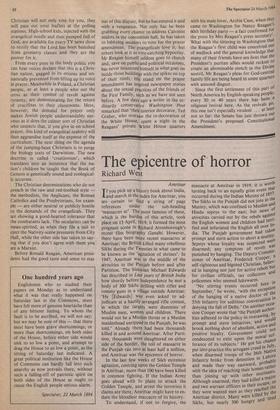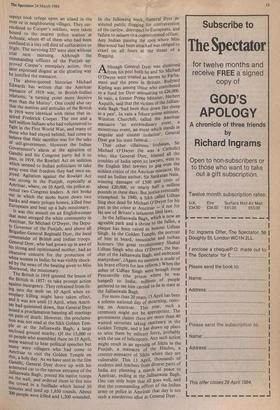The epicentre of horror
Richard West
Amritsar Tf you pick up a history book about India, land search in the index for Amritsar, you are certain to find a string of page references under the sub-heading 'massacres at'. The most famous of these, which is the burden of this article, took place on 13 April, 1919; it formed the most poignant scene in Richard Attenborough's recent film biography Gandhi. However, there have been more recent massacres at Amritsar: the British killed many rebellious Sikhs during the Twenties in what came to be known as the 'agitation of shrines'. In 1947, Amritsar was in the middle of the atrocities in the Punjab before and after Partition. The historian Michael Edwards has described in Last years of British India how shortly before Independence he met a body of 300 Sikhs drilling with rifles and tommy guns in a village outside Amritsar: 'He [Edwards] was even asked to ad- judicate at a hastily arranged rifle contest, in which the targets were dummies of Muslim men, women and children. There would not be a Muslim throat or a Muslim maidenhead unripped in the Punjab, he was told.' Already there had been thousands killed in and around Amritsar. After Parti- tion, thousands were slaughtered on either side of the border, the toll of massacre in the Punjab ran into at least half a million, and Amritsar was the epicentre of horror.
In the last few weeks of Sikh extremist agitation, centring upon the Golden Temple in Amritsar, more than 100 have been killed in common fighting.. If the Indian Army goes ahead with its plans to attack the Golden Temple, and arrest the terrorists it claims are there, Amritsar might have to en- dure the bloodiest maccacre of its history.
To understand, if not to forgive, the
massacre at Amritsar in 1919, it is worth turning back to an equally grim event that occurred during the Indian Mutiny of 1857. The Sikhs in the Punjab did not join in the Mutiny, which was confined to Muslim and Hindu sepoys to the east; but news of atrocities carried out by the rebels against the English women and children had terri- fied and infuriated the English all over In. dia. The Punjab government had taken prompt and stern action to abort a mutiny Sepoys whose loyalty was suspected were disarmed; any symptom of revolt was punished by hanging. The Deputy Commis- sioner of Amritsar, Frederick Cooper, a self-righteous and bigoted Christian, believ- ed in hanging not just for active rebels but for civilian officials, tax collectors and policemen who seemed lukewarm. 'No stirring events occurred here in September,' he wrote, 'with the exception of the hanging of a native doctor of the 35th Infantry for seditious conversation in denying the fall of Delhi.' On another occa- sion Cooper wrote that 'the Punjab author- ities adhered to the policy in overawing, by prompt and stern initiatives, and would brook nothing short of absolute, active an°, positive loyalty. Government could n. condescend to exist upon the moral suf- ferance of its subjects.' He got his chance put into practice this arrogant creed in wive when disarmed troops of the 26th Native Infantry broke from detention in Lahore and made their way eastward, probably with the idea of reaching their homes rather than joining up with other mutineers. Although unarmed, they had killed a rna.1°_r and two warrant officers in their escape, isi° they were wanted men as they reached the Amritsar district. Many were killed by t e. Sikhs, but nearly 300 hungry and tire°
sepoys took refuge upon an island in the river or in neighbouring villages. They sur- rendered to Cooper's soldiers, were taken bound to the nearest police station at Achnala, where 45 of them who had been confined in a tiny cell died of suffocation or fright. The surviving 237 were shot without trial next morning. Although the commanding officers of the Punjab ap- proved Cooper's exemplary action, they later expressed disgust at the gloating way he justified the massacre.
The above-quoted historian Michael Edwards has written that the Amritsar massacre of 1919 was, in British-Indian relations, 'a turning point more decisive even than the Mutiny'. One could also say that the motives and attitudes of the British in 1919 were identical with those that in- spired Frederick Cooper. The one and a half million Indians who had volunteered to fight in the First World War, and many of those who had stayed behind, had come to believe that their sacrifice was for the sake of self-government. However the Indian Government's alarm at the agitation of Gandhi and his Congress party led it to Pass, in 1919, the Rowlatt Act on sedition which seemed to Indian politicians to take away even that freedom they had once en- loyed. Agitation against the Rowlatt Act Was strong in the Punjab, especially at Amritsar, where, on 10 April, the police ar- rested two Congress leaders. A riot broke out in which the mobs burnt down two banks and many private homes, killed four Europeans and beat up a lady missionary.
It was this assault on an Englishwoman that most enraged the white community in Amritsar, Sir Michael O'Dwyer, the Depu- ty Governor of the Punjab, and above all Brigadier-General Reginald Dyer, the local commander of British and Indian troops. General Dyer, who had grown up in awe of his strong and opinionated mother, had an obsessive concern for the protection of white women in India; he was visibly shock- ed by the news of the beating given to Miss Sherwood, the missionary. The British in 1919 ignored the lesson of the British in 1857: to take prompt action a. gainst insurgency. They refrained from fir- ing into the mob on 10 April when ex- emplary killing might have taken effect, and it was not until 13 April, when Amrit- sar had quietened down, that General Dyer Issued a proclamation banning all meetings 011 pain of death. However, the proclama- tion was not read at the Sikh Golden Tem-
ple or at the Jallianwala Bagh, a large enclosed ground nearby. Of the 15,000 or so people who assembled there on 13 April, some wanted to hear political speeches but many were villagers who had come to
Amritsar to visit the Golden Temple on
this, a holy day. As we have seen in the film Gandhi, General Dyer drove up with his armoured car to the narrow entrance of the Jallianwala Bagh, posted his native troops on the wall, and ordered them to fire into
the crowd in a fusillade which lasted 10 minutes and used up 1,650 rounds. About 300 people were killed and 1,200 wounded.
In the following week, General Dyer in- stituted public flogging for contravention of the curfew, disrespect to Europeans, and failure to salaam to a commissioned officer. Any Indian passing the spot where Miss Sherwood had been attacked was obliged to crawl on all fours at the threat of a flogging.
A lthough General Dyer was dismissed -i.from his post both he and Sir Michael O'Dwyer were treated as heroes by Parlia- ment and the press in Britain. RudYard Kipling was among those who contributed to a fund for Dyer amounting to £26,000. In vain, a former Prime Minister, Herbert Asquith, said that the victims of the Jallian- wala Bagh 'had been shot down like sheep in a pen'. In vain a future prime minister, Winston Churchill, called the Amritsar massacre 'an extraordinary
event, a
monstrous event, an event which stands in singular and sinister isolation'. i General Dyer got his state funeral. That other villainous Irishman, Sir Michael O'Dwyer (he was a Catholic) who, like General Dyer, blamed all the troubles of India upon its lawyers, went to the English libel lawyers to gag even the mildest critics of the Amritsar massacre. H e sued an Indian author, Sir Sankaran Nain, winning damages of £500 and costsof about £20,000, or nearly half a million pounds in these days. But justice eventually triumphed. In 1940, a Sikh called Udhan Sing shot dead Sir Michael O'Dwyer for his part in the crime at Amritsar — if not for his use of Britain's infamous libel laws. In the Jallianwala Bagh, which is now an agreable park and a shrine to the fallen, a Singh. . In th plaque ihasbe oldeoenraninsed.remtophirour Udhan gh the portrait of him in beard, moustache and turban uhodnhoaunrsstn'tghhe wghreoatshroetvoolutionary Shahid but- cher of the Jallianwala Bagh, and the but- and embraced martyrdom'. (Again no mention is made of his brave efforts for law reform.) When the
pasehnetsonovfUe (the prison brough from ill where he was hanged) to India, millions of people gathered to see him carried to lie in state at the Jallianwala Bagh. For more than 20 years, 13 April has been
a solemn national day of mourning, centr- ing on Amritsar. This year, such a ceremony might not be appropriate. The government claims there are more than 40 wanted terrorists taking sanctuary in the Golden Temple, and it has drawn up plans to seize them by military force, probably with the use of helicopters. Any such action might result in an uprising of Sikhs in the Punjab, a massacre of the Hindus, a counter-massacre of Sikhs where they are vulnerable. This 13 April, thousands of students and teachers from diverse parts of India are planning a march of peace to Amritsar, ending at the Jallianwala Bagh. One can only hope that all goes well, and that the commanding officer of the Indian army or police in Amritsar that day is not such a murderous idiot as General Dyer.











































 Previous page
Previous page